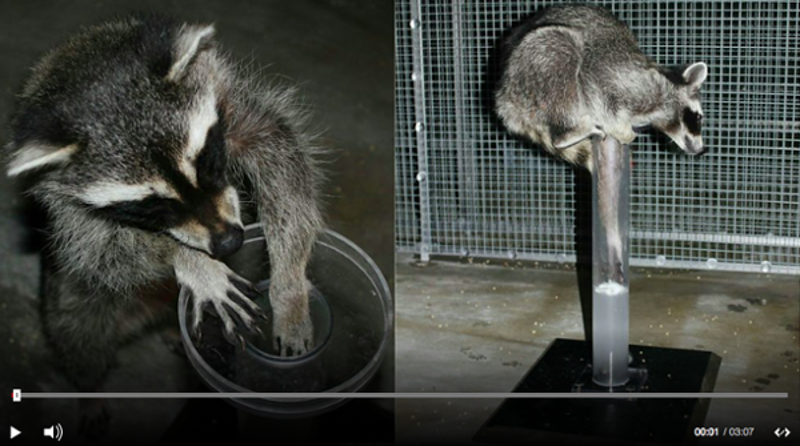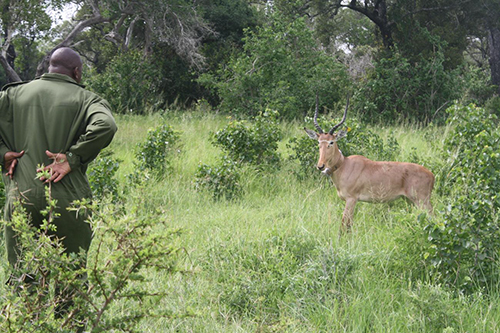Contact Us





Program in Ecology
Transdisciplinary Program
Debbie Swierczek, Program Coordinator
School of Graduate Education
Knight Hall 247
Phone: 307-766-4128
Email: ecology@uwyo.edu
Program in Ecology Research in the News
In Sagebrush Country, Drilling Brings Nest-Raiding Rodents
Scientists and federal experts are finding that habitat restoration in oil and gas fields can have unexpected consequences for Wyoming's songbirds.
Originally published November 22, 2017 on www.audubon.org
Greater Sage-Grouse are media darlings. Just as the male’s haughty, heaving springtime dance woos mates from miles around, the species has attracted headlines and become a mascot of sorts for efforts to protect the West’s sagebrush steppe from energy development and other threats. The sage-grouse deserves the spotlight, too: Its numbers plunged by more than 50 percent between 2007 and 2013, and habitat lost to sprawling oil and gas infrastructure is a key factor. And with Interior Secretary Ryan Zinke intent on scrapping a carefully crafted conservation plan to preserve its ecosystem across 11 states, the species faces a forbidding future. But it’s just one of nearly 300 bird species in the sagebrush, and is not the only one losing ground.
Like the Greater Sage-Grouse, Brewer’s Sparrow, Sagebrush Sparrow, and Sage Thrasher nest only in the sagebrush, and all three are declining. Pipelines, well pads, and access roads built by oil and gas companies have sliced and flayed their habitat, leading the Wyoming Game and Fish Department to label all three songbirds as “species of greatest conservation need.” Teasing apart how those birds respond to energy development has been a nearly decade-long project for Anna Chalfoun, an ecologist with the University of Wyoming and U.S. Geological Survey. The more Chalfoun and her colleagues learn about the industry's impacts, the clearer it becomes that it’s not only the act of drilling that affects these sensitive songbirds—it also matters what happens to the land after the work is done.
Wyoming has more sagebrush than any other state, and about two-thirds of it sits atop oil and gas reserves. It was that overlap of sensitive habitat, declining songbirds, and intensifying energy development that led Chalfoun to take up this line of research in 2008. “We have some of the last contiguous chunks of sagebrush in the West,” she says. “So I feel there’s a strong impetus for us to understand what it means to fragment that habitat further.”
A growing focus of her work has been the results of restoration. When their work is finished, energy companies have to replant vegetation to “reclaim” any areas cleared or otherwise disturbed by drilling infrastructure. In return for cleaning up their mess, they get a refund on bonds they post before breaking ground. But that’s easier said than done. Plant communities in dry environments tend to recover slowly from disturbance, and that’s especially true of Wyoming sagebrush.
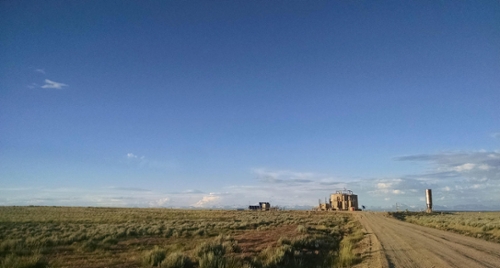
That long rebound period raises the stakes of energy development for sagebrush songbirds. One measure Chalfoun and collaborators use to gauge the industry’s impact on birds is nesting success: the percentage of nests where at least one chick lives long enough to fledge. Their research shows that overall habitat disturbance, including reclaimed parcels, pipelines, and roads, is a more important factor in nest-success rates than the number of wells in the area. For instance, only 32 percent of Sage Thrasher nests were successful in heavily disturbed areas, Chalfoun found, compared to a 65 percent in undisturbed sagebrush. Nest success in heavily disturbed areas also plunged by nearly half for Sagebrush Sparrows and by about one-third for Brewer’s Sparrows.
Chalfoun knew from previous studies that predation was the main reason nests fail, so she set up camouflaged video cameras in the sagebrush to identify predators. The footage revealed nest raids by nine species such as raptors and raccoons, but the biggest killers by far were rodents like deer mice and ground squirrels. “That the mice are such a significant nest predator has been super surprising,” Chalfoun says. “It’s gory sometimes. They aren’t just stealing eggs.” Indeed, the videos showed deer mice maiming and dragging away thrasher nestlings roughly double their size.
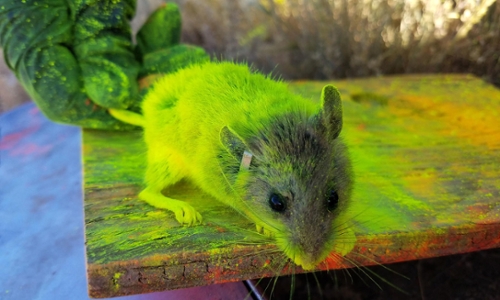
Chalfoun also counted more than twice as many deer mice in disturbed areas, including reclaimed land, than in intact sagebrush. Something about the disturbances attracted rodents, it seemed. To investigate further, Chalfoun’s graduate student Lindsey Sanders took the project in a psychedelic direction: She captured deer mice along the edge of reclaimed parcels and brushed their fur with fluorescent powder, which glows under ultraviolet light. Sanders returned at night to discover glowing trails through the reclaimed areas, exposing them as popular mouse haunts.
But every good hangout spot needs food. By analyzing DNA in fecal samples, a lab confirmed that the mice Sanders captured had noshed on common timothy, basin ryegrass, and Russian thistle—plants that were sown on reclaimed sites. The vegetarian buffet that follows reclamation, it appears, is attracting rodents, which supplement their diets by raiding the nests of imperiled songbirds. “Now we know a little more about why energy development is drawing in these nest predators that are leading to lower nest survival,” Sanders says.
The findings from Chalfoun’s lab demonstrate that sagebrush ecosystems are complex, and truly reclaiming them isn’t as simple as planting some seeds. “When I got started in the field of land reclamation, it was called re-vegetation,” says Peter Stahl, director of the Wyoming Reclamation and Restoration Center, who works with energy companies to improve their reclamation. “Now we’re all about wildlife habitat restoration here in Wyoming. We’re trying to get native-plant communities restored and get habitat restored.”
Sagebrush is included in the seed mixes for reclamation, but it takes an eternity to grow compared to mouse-friendly grasses and forbs; big sagebrush, a dominant species in much of the West, needs nearly a century to recover on its own in Wyoming, one recent study found. Reclamation may accelerate that process, “but even then, success in establishing big sagebrush on oil and gas wells with current re-vegetation methods has still been very low and very slow,” says William Lauenroth, a Yale University plant ecologist who co-authored that paper. His work has shown that reclamation in Wyoming oil and gas fields accelerated grass recovery, but did not bring back sagebrush or perennial forbs any faster than on sites that were simply abandoned.
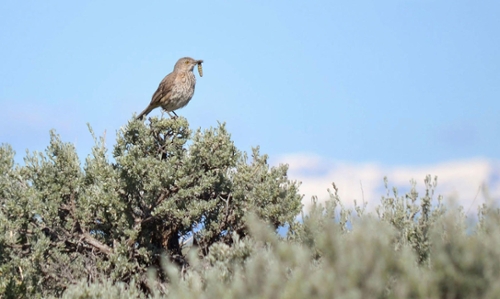
One challenge to better reclamation, Lauenroth and Stahl say, is the contrasting set of standards energy companies are held to on lands they lease across the West. Reclamation requirements are up to private landowners on private lands, state agencies on state lands, and the Bureau of Land Management (BLM) on federal lands. “It’s definitely a patchwork,” Stahl says. “Within BLM, just about each district office has its own set of standards that companies have to meet. They need to make their regulations a little bit more uniform.”
Another problem is that drillers need a tastier carrot to make reclamation worthwhile. “The companies are putting up a bond that is absolutely ludicrous, it’s so small,” Lauenroth says. “They don’t have much incentive to invest in making sure these sites recover.” The nonpartisan U.S. Government Accountability Office agreed in a 2011 report, noting that BLM’s minimum bonding amounts hadn’t been updated in 50 years and were likely too low to compel drillers to complete reclamation projects.
Ashlie Fahrer, a public affairs specialist for BLM, wrote in an email to Audubon that the agency is working to make its reclamation standards more uniform and measurable, and has issued a policy to periodically review bonding requirements. BLM is also designing a project to increase the quality and quantity of seed available for reclamation projects, she noted.
There are other ways to speed up sagebrush habitat recovery, though. Planting nursery-grown seedlings instead of just spreading seed would help, Lauenroth says, and so would a greater focus on preparing soils before planting. Reclamation is already expensive, and doing it better will only increase the price tag. But if we’re asking the sagebrush steppe to support both continued energy development and healthy songbird populations, it may just be the cost of doing business.
Meet the Raccoons That Solved an Ancient Puzzle
Originally published October 2, 2017 on BBC World Service Newsday
"The Crow and the Pitcher" is one of Aesop's fables that has puzzled scientific minds. The story goes like this: a thirsty crow realises it should drop stones into a pitcher in order to raise the water level high enough so that the bird is able to drink it. In relation to this, researchers have been using the ancient Greek fable as inspiration to test whether birds and small children understand cause and effect relationships. A group of US scientists have now extended this body of work to study raccoon intelligence. In the experiment, eight raccoons had to work out how to retrieve floating pieces of marshmallow from a tube. Lauren Stanton of the University of Wyoming is the lead researcher. Hear the story on BBC World Service Newsday.
UW Receives $20 Million Grant for Unprecedented Microbial Research Efforts
Originally published September 19, 2017 on uwyo.edu
When people look across Wyoming, they see the variety of terrain, vegetation and other life that make up the state’s landscapes, from plains grasslands and productive farmland to sagebrush-steppe deserts and alpine forests.
What they don’t see are the innumerable bacteria, fungi and other microbes in the soil, water and air that shape life in the Cowboy State.
Over the next five years, University of Wyoming researchers will take an up-close look at those unseen organisms at an unprecedented scale, thanks to a $20 million grant from the National Science Foundation (NSF). And, using cutting-edge techniques including DNA sequencing and computational modeling, the scientists hope to learn the distribution and ecological consequences of microbes, producing insights that will help Wyomingites address a variety of challenges -- from managing rangeland, forest and water resources, to reclaiming areas disturbed by mineral extraction, to improving crop productivity.
In the process, the university expects to stimulate significant economic and business opportunities across the state -- and engage people from elementary school pupils to community college students to business leaders in scientific discovery.
“This grant will allow us to conduct microbial research at a scale that isn’t taking
place anywhere else on the planet,” says Bill Gern, UW’s just-retired vice president
for research and economic development.
“This will enhance our research capacity and competitiveness along with the state’s workforce and economy, creating intellectual property that can be applied to economic sectors relevant to Wyoming, including the fast-growing field of data science, which has an enormous range of applications,” says Ed Synakowski, Gern’s successor.
The grant was among five announced today (Tuesday) through NSF’s EPSCoR (Established Program to Stimulate Competitive Research) program, which supports efforts to enhance research, science and mathematics education, and workforce development. The award comes on the heels of another five-year, $20 million NSF grant in 2012 -- at the time, the largest research grant in UW history -- that stimulated wide-ranging research into Wyoming’s water resources.
“These investments by NSF promise to yield fundamental understanding in research areas of regional and national importance while catalyzing new educational and training opportunities for students and researchers,” NSF Director France Cordova says. “This year’s EPSCoR awards continue to demonstrate the vitality of scientific inquiry and innovation, which is present in universities and research laboratories across the nation.”
UW President Laurie Nichols says the new grant leverages and complements Wyoming’s investments in high-performance computing and the university’s Science Initiative -- which aims to transform science education across the state while driving innovation and economic progress.
“This grant is an example of how the commitment of the Legislature and the governor to upgrade UW’s scientific infrastructure will pay dividends for the people of Wyoming and our quality of life,” Nichols says. “It touches on all aspects of the university’s three-fold mission of providing top-caliber educational opportunities for our students, conducting research to benefit the state and meeting the needs of Wyoming through service.”
This highly interdisciplinary award, bringing together researchers and educators from multiple UW colleges, is led cooperatively by principal investigators Brent Ewers, Cynthia Weinig and Alex Buerkle, professors of botany; Naomi Ward, associate professor of molecular biology; and Linda van Diepen, assistant professor of ecosystem science and management.
A New Age of Discovery
While the presence of bacteria, fungi and other microbes has been known for centuries, human understanding of the diversity of microbial life -- and its role in human biology, ecology and agriculture -- is still rudimentary, the UW researchers say. That is changing because of major advances in technology, particularly in DNA sequencing and high-performance computing.
“This is an age of discovery in microbiology,” says Buerkle, who studies genetic consequences of evolutionary adaptation. “Just as modern telescopes have given astronomers the ability to see the universe with amazing detail, our new genomic sequencing capabilities have opened a whole new world in the study of life.”
With this grant, UW will be on the cutting edge of using biotechnology to study the natural world. Specifically, the university’s technology in sampling microbes from Wyoming’s landscapes; sequencing the DNA of those microbes; and using computer models of microbial life will be at the forefront of science.
The grant will fund the next generation of equipment for UW’s Advanced Research Computing Center; create new on-campus centers for liquids handling, biogeochemistry and data science; and allow for the hiring of three faculty members, numerous postdoctoral researchers and graduate students, as well as facilitate undergraduate student research.
Sampling of Wyoming soil, plants, water and air will be done at hundreds of sites across the state -- from mountaintops to basin bottoms -- primarily on public lands and in cooperation with private partners. The “pipeline” of sample collection, storage and analysis will involve UW and community college students, K-12 teachers and others. And the resulting Data Science Center will reach across campus and around the state, creating unprecedented opportunities for students to engage in the cutting edge of genomics, the study of the entire DNA sequences of organisms and statistical analyses -- crucial components of the contemporary growth in the economy related to life sciences and data science.
Beyond opportunities in the technology sector, potential benefits for the state include improved knowledge of invasive plants and microbes; improving crop production; improving reclamation of lands disturbed by development; and, in general, managing lands more effectively.
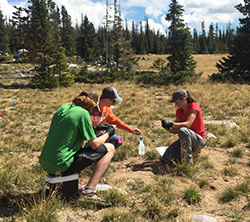 “Any good naturalist can look at a field and see the plants there and understand the
life cycle and the interrelated species that live there, but in that same field are
hundreds of billions of microscopic living organisms we don’t know much about,” says
Weinig, whose research involves evolutionary genetic analysis of adaptation in nature.
“By learning about the microbes that are there, and what they do, we will be able
to identify functions that might be improved for plants, grazing animals and other
users of the land.”
“Any good naturalist can look at a field and see the plants there and understand the
life cycle and the interrelated species that live there, but in that same field are
hundreds of billions of microscopic living organisms we don’t know much about,” says
Weinig, whose research involves evolutionary genetic analysis of adaptation in nature.
“By learning about the microbes that are there, and what they do, we will be able
to identify functions that might be improved for plants, grazing animals and other
users of the land.”
“Once we know what organisms are there, including their genetic capacity, we can figure out how we can make use of them,” says van Diepen, whose research includes the role of soil microbes in restoring forests after wildfire, soil remediation of contaminated mine lands and microbial interactions with invasive plants such as cheatgrass.
Ward adds that the project "applies the same approaches used so successfully to understand the microbial communities associated with the human body.
“Human microbiome studies have provided clear evidence that some microbes are essential for our health, while others predispose us to disease,” she says. “In the same way, this new project will provide information on how some microbial groups support healthy ecosystems, while others are associated with environmental imbalances.”
Why Wyoming?
Wyoming is ideal for research of this nature and scope because of the variety of its lands, including elevation, temperature, moisture and land use, the researchers say. Rapid changes in elevation and soil type often occur over small distances, and these steep gradients will give scientists an excellent window to study the variety of microbes and their functions.
Wyoming also provides unusual access to pristine lands and waters, as well as systems disturbed by resource extraction, dams and water diversions.
The project will train members of the Northern Arapaho and Eastern Shoshone tribes in sample collection and laboratory and statistical analyses of microbiomes from the Wind River Indian Reservation. This work by the two sovereign tribes will not only answer new questions about land management, but also aid in economic development.
In fact, the microbe that Buerkle says launched the biotechnology revolution was discovered in the Mushroom Pool of Yellowstone National Park’s Lower Geyser Basin in Wyoming in 1966. In the mid-1980s, scientists discovered that Thermus aquaticus, which survives in extremely high temperatures, made DNA testing much more practical. This fortuitous discovery led to the biotechnology industry, generating billions of dollars a year and creating scientific breakthroughs in medicine and agriculture.
Bioprospecting for other useful Wyoming microbes could lead to discovery and commercialization of new products, the UW researchers say. And there will be significant entrepreneurial opportunities as a result of associated data science capacity.
“This project will provide a mechanism to counteract the boom-and-bust cycles of Wyoming’s energy-based economy,” says Ewers, who researches how plants control the flow of energy and mass at small and large scales. “This is an opportune time for training and workforce development in data science, with the particular application here to microbial ecology.”
The West's Newest Bird Species Has a Beak Like A Crowbar
Originally published July 12, 2017 on hcn.org
At 6:30 one morning in early July, Craig Benkman, a University of Wyoming ecologist, began to stalk red crossbills in the South Hills of Idaho. We were between Twin Falls and the Nevada border, outside a cabin tucked into a forest near a minor ski hill, Magic Mountain. He and several of his graduate students had quietly strung ornithology’s signature ploy, a diaphanous mist-net, between two metal poles. It hung nearly invisible, low to the ground, below two lodgepole pines. Several of these sanguine birds — a large finch with a beak that looks curiously off-kilter, one mandible overlapping the other — were resting in the grass by a salt lick. Crossbills feed exclusively on the seeds of conifer cones, and must supplement their diet with sodium. “It’s like how, in the Sierra, marmots chew on your sweaty boots,” Benkman explained. Typically the birds might swallow a little clay from the roots of a fallen tree for salt, but here cabin owners had arranged mineral blocks in the grass to lure moose and deer nearer to their windows. Benkman peered through his binoculars at a male sitting with several others beside the net, all of them looking up warily with glossy black eyes. The male’s domed head, breast and rump were the crimson of an heirloom tomato, flecked with orange, with yellow ochre. “Oh,” Benkman said, in a rising whisper. “An unbanded one.”
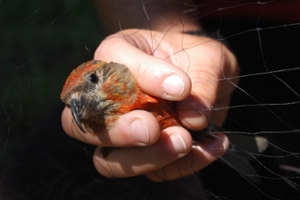 Six feet four, thin and bespectacled, Benkman has a hushed voice and a sense of humor
as dry and pleasant as the sagebrush- and wildflower-spotted South Hills. He is an
old-school naturalist and an intuitive, holistic thinker, something increasingly rare
in this era of computational biology and specialization. Walking the South Hills,
he refers to minute flowers by their Linnaean names and muses about the West’s big
ecological picture as his jeans swish through the fragrant scrub. For more than 30
years, he has studied crossbills across North America, as well as in aviaries, and
for the past 20 summers, he has visited this remote mountain range on the edge of
the Great Basin, where he and his students aim to capture as many crossbills as possible
and mark them with colored leg bands. When he received the prestigious E.O. Wilson
Award from the American Society of Naturalists in 2014, the judges remarked that his
crossbill work “rivals long-term field studies of the Galapagos finches.”
Six feet four, thin and bespectacled, Benkman has a hushed voice and a sense of humor
as dry and pleasant as the sagebrush- and wildflower-spotted South Hills. He is an
old-school naturalist and an intuitive, holistic thinker, something increasingly rare
in this era of computational biology and specialization. Walking the South Hills,
he refers to minute flowers by their Linnaean names and muses about the West’s big
ecological picture as his jeans swish through the fragrant scrub. For more than 30
years, he has studied crossbills across North America, as well as in aviaries, and
for the past 20 summers, he has visited this remote mountain range on the edge of
the Great Basin, where he and his students aim to capture as many crossbills as possible
and mark them with colored leg bands. When he received the prestigious E.O. Wilson
Award from the American Society of Naturalists in 2014, the judges remarked that his
crossbill work “rivals long-term field studies of the Galapagos finches.”
The mist-net swayed, reminding the nervous birds in the grass of its shadowy presence. “I wish the wind would just stop,” Benkman said, as if to the wind itself. “This is where I think you need to be aggressive and try to spook them. You take off your shirt and throw it — make it look like a goshawk.” He started to peel the plaid shirt from his long pale torso, but I offered up the green fleece I’d shed already. Benkman tied it into an aerodynamic knot, a mock raptor. “For an unbanded bird?” he said. “You can’t just stand idly.” He began to slink circuitously toward the salt lick.
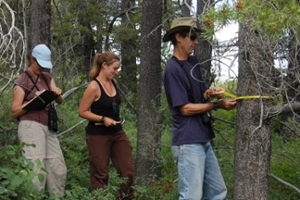
Various species of crossbill live throughout the Northern Hemisphere, from Morocco to the Himalayas, Japan to Hispaniola, Vietnam to Scotland. European folklore has it that, while Jesus hung on the cross, a roaming finch came to his aid, pulling at the nails in vain, bathing its plumage in blood, wounding itself and mangling its bill forever — transfiguring into the crossbill. The evolutionary explanation is simpler, but perhaps no less miraculous: Crossbills are extraordinarily well adapted for opening cones. Put your index finger over the knuckle of your thumb, as Benkman taught me, and you shape the bird’s cleft, which it jams between two scaly bracts. As it bites down, the curved tips press in opposite directions, prying the scales apart. Next it flexes its lower mandible (your thumb) sideways, using a muscle that is hyper-developed on one side of its face. Then the bird’s pink tongue — so long that it wraps behind its skull when retracted, as in hummingbirds and woodpeckers — slips in for the tiny seed in its papery wing. Finally, the crossbill husks the seed using a special groove on its upper palate. To sustain itself, a South Hills crossbill performs this sequence about 1,500 times a day.
When crossbills are feeding happily, all you hear is the soft rain of translucent husks slipping through needled branches. Then one might let forth a kip. For the red crossbill, Loxia curvirostra (“curved nose”), this call note is the key to another peculiarity: Unlike most birds, it comes in a range of body and beak sizes, a smooth, vermilion continuum from relatively delicate to bulky. This diversity confounded birders for more than a century because our very notion of a species is predicated on interbreeding, which tends to generate uniformity. But as it turns out, each relative size has its own inflected kip. There are 10 red crossbill “call types” in North America, and the birds within each type seem to mate and flock among themselves. Yet an individual bird can’t be “typed” reliably by measurement or ear. Only a spectrograph of the call — a visualization that recalls the brushstrokes of Japanese calligraphy — can diagnose a red crossbill definitively. The kip variants help the birds identify and stick with other red crossbills that have similar-sized bills, since when everyone has the same “tool,” and thus the same standards, a flock can better judge the caliber of cones. They watch each other and broadcast information about seed abundance by voice. “It’s as if they’re calling, ‘I’m doing poorly — how are you doing?’ ” Benkman told me. “If nobody else calls, ‘Well, I got a bad branch, a bad cone,’ then they keep foraging and quiet up. But if they all call, ‘I’m doing poorly, you’re doing poorly,’ then it’s a bad tree, and they move on.” But these cues are only reliable if everyone is similarly equipped.
As a young Loxia-phile, Benkman made his name, in part, when he hypothesized that red crossbill types might be specialized to feed on conifers that hold their seeds year round, making them stable resources. To test this suspicion, he performed a now-classic Darwinian experiment: In aviaries, he measured crossbills’ feeding rates on the Northwest’s “key conifers,” and he found that each call type in the region just about matched the perfect bill depth for exploiting one species of cone. Large bills are ideal for ample, bony cones like ponderosa pine; lesser bills for tiny, soft cones like hemlock. As Benkman later put it in a paper, “Their bills are as finely adapted to a cone as a key is to a lock.” Coupled with the call type phenomenon, this revelation has encouraged ornithologists to speculate that some or all of the call types might be “cryptic” species hidden in our midst, each filling a different coniferous niche. Parsing the red crossbill, and potentially paring it into species, has long been considered one of ornithology’s most tantalizing problems
Read the article in its entirety at High Country News.
Scientists Solve Fish Evolution Mystery
Originally published February 10, 2017 on phys.org
A University of Wyoming researcher is part of an international team that has discovered how more than 700 species of fish have evolved in East Africa's Lake Victoria region over the past 150,000 years.
Catherine Wagner, a UW assistant professor in the Department of Botany and the UW Biodiversity Institute, describes the phenomenon—unparalleled in the animal and plant world—as "one of the most spectacular examples of the evolution of modern biodiversity."

She and fellow researchers from Switzerland's University of Bern and the Swiss Federal Institute of Aquatic Science and Technology have demonstrated for the first time that the rapid evolution of Lake Victoria cichlids—brightly colored, perch-like fish—was facilitated by earlier hybridization between two distantly related cichlid species from the Upper Nile and Congo drainage systems.
The research is published today (Friday) in the journal Nature Communications. The first author on the paper, Joana Meier, is a Ph.D. student Wagner co-supervised at the University of Bern. Wagner, along with Meier's other supervisors—Laurent Excoffier and Ole Seehausen—are senior authors of the paper.
Wagner says the rapid evolution of the East African cichlids had puzzled researchers, who didn't understand how a single common ancestor could divide into 700 species so quickly. The discovery that the ancestor of these fish species was actually a mixture of two different ancestors from different parts of Africa makes it "much easier to understand how the immense variety of fishes in this region have evolved," she says.
"An analogy is: If you combined the pieces from two very different Lego sets—say, a tractor and an airplane—you could get a much wider variety of possible structures," Wagner says.
The species that evolved exhibit many combinations of colors and are adapted to different habitats, such as sandy bottoms, rocky shores or open waters—ranging from the clear shallows to the permanent darkness of the turbid depths, according to a media release from the Swiss Federal Institute of Aquatic Science and Technology. Depending on the species, cichlids may scrape algae from rocks, feed on plankton, crack open snail shells, forage for insect larvae or prey on other fish, including their eggs or scales.
The hybridization event probably took place around 150,000 years ago, when—during
a wet period—a Congolese lineage colonized the Lake Victoria region and encountered
representatives of the Upper Nile lineage. Across the large lakes of this region,
the hybrid population then diversified in a process known as adaptive radiation, or
evolution of multiple new species adapted to different ecological niches.
While the precise course of events in ancestral Lake Victoria has yet to be reconstructed, it is clear that, after a dry period, it filled up again about 15,000 years ago. Descendants of the genetically diverse hybrid population colonized the lake and, within the evolutionarily short period of several thousand years, diverged to form at least 500 new cichlid species, with a wide variety of ecological specializations. The particular genetic diversity and adaptive capacity of Lake Victoria's cichlids is demonstrated by the fact that more than 40 other fish species—which colonized the lake at the same time—have barely changed since then.
The study involved sequencing over 3 million sites in the genome of 100 cichlid species—a task which, until recently, would not have been feasible.
Wagner's study of evolutionary adaptive radiation earned her the 2015 Theodosius Dobzhansky Prize as an outstanding young evolutionary biologist from the Society for the Study of Evolution.
Wagner has published a range of papers in top-tier journals, including Nature, Nature Reviews Genetics, Evolution and Molecular Ecology. At UW, she and her lab focus on using genetic and ecological data to study the evolution of biodiversity, primarily in freshwater fish. Her research uses population genetic, genomic, phylogenetic and comparative methods to study diversification, from speciation processes to macro-evolutionary patterns of biodiversity.
Wagner received her Ph.D. from Cornell University in 2011, and she was a postdoctoral research associate at the Swiss Federal Institute of Aquatic Science and Technology before starting as an assistant professor at UW in 2015. She received her bachelor's degree in biology and geology from Whitman College.
Is Climate Change Pushing Pikas Up the Mountain?
Originally published February 3, 2017 on wyomingpublicmedia.org
There aren’t many critters crazy enough to live year round on mountaintops. So any that do live there have got to be tough. Like the American pika, an adorable little round-eared — and noisy — animal that lives in the rocks at the highest elevations.
But are pikas tough enough to survive a warming planet? University of Wyoming researcher
Embere Hall is trying answer that question.
She says, twice the American pika has been petitioned for listing on the endangered species list, but both times it was turned down because of a lack of scientific data on the species. Hall says she hopes her research can help fill in some of that gap in the future. Visit the link above to listen to Embere's interview with Wyoming Public Media!
A River Otter's Hot Spot? The Latrine
Originally published September 19, 2016 on NYTimes.com
River otters on the coast of Alaska lead unusual lives. For the males, much of their
social life centers on a shared bathroom area.
Other animals, like honey badgers and meerkats, also share bathroom sites, called
latrines. And they pick up information about other members of their species from the
scents left there.
River otters, which are in the same family as sea otters but a different genus, not
only pick up information from scat and urine and anal gland emissions, but have all
sorts of social interactions around the bigger latrines.
Adi Barocas, a doctoral student at the University of Wyoming, has been studying river
otters as part of a project that the university has had going for about 25 years.
It began shortly after the 1989 Exxon Valdez oil spill off the Alaskan coast.
The project involves research on many aspects of otter life, including how they form
social groups. Among coastal river otters, which are different from more inland populations,
the males live and forage for fish in fluid groups of as few as four otters or as
many as 18. Females are solitary, and males leave their groups during mating season
to find females.
When the males are together, however, they play and groom each other and, before they
defecate, often do what Mr. Barocas describes as “the poop dance.”
In videos taken by cameras set up near latrines, the male otters wave their back ends
rhythmically, stepping from one hind foot to the other.
Exactly what the poop dance means isn’t clear, Mr. Barocas said. But he and Merav
Ben-David, his adviser, and other researchers, reported in the October issue of Animal Behaviour, that the interactions at the latrines are helping the males decide which groups
to join. They may be learning, for example, which otters are catching more fish, from
chemical clues in the scat.
One thing made clear in the many hours of video: These otters give new meaning to
the term “party pooper.”
World’s rarest antelope GPS collared for first time
January 25, 2013
Hirola can now be monitored in an attempt to save this critically endangered species A FIRST ever attempt to GPS collar wild hirola in their native range has been hailed a success by conservationists from the Zoological Society of London (ZSL).
A total of nine animals were identified by field-workers in Kenya who spent eighteen months monitoring their habitat. Seven herds of hirola were identified between Boni Forest and the Tana River in north-eastern Kenya. Adult hirola were carefully captured and GPS collars fitted before they were left to roam free once again.
Cath Lawson, ZSL’s EDGE Programme coordinator says: “Hirola is an EDGE (Evolutionarily Distinct and Globally Endangered) species - one of the most unique and threatened animals on the planet. Over the past thirty years numbers have plummeted by almost 90 percent, and they continue to decline.
“As the sole representative of its group, the loss of the hirola would be the first extinction of a mammalian genus on mainland Africa in more than 100 years,” Cath added.
GPS collars were fitted to at least one individual per herd, allowing conservationists to record vital information on population growth, group movements and behaviours.
Conservationists in the field work closely with the Kenya Wildlife Service and local communities to locate hirola herds by distinguishing the footprints and faeces of hirola from those of other ungulates found in the same area.
There are an estimated 400-500 hirola living today, but these animals continue to be severely threatened by some combination of drought, predation, poaching, and habitat loss.
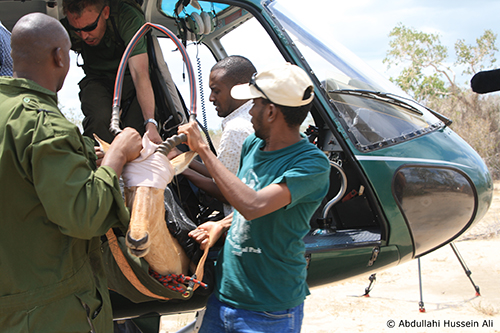 ZSL’s EDGE Fellow and University of Wyoming doctoral student Abdullahi Hussein Ali (pictured left, in teal shirt) says: “GPS radio-collars record one location every
three hours throughout the year, and provide us with vital information on movement
patterns which we wouldn’t otherwise get.
ZSL’s EDGE Fellow and University of Wyoming doctoral student Abdullahi Hussein Ali (pictured left, in teal shirt) says: “GPS radio-collars record one location every
three hours throughout the year, and provide us with vital information on movement
patterns which we wouldn’t otherwise get.
“Because of the elusive nature of the hirola, identifying different herds for collaring was not an easy task. This particular habitat had also recently been hit by drought, so it made our job harder as it caused the hirola to disperse further in search of greener pastures,” Ali added.
The GPS collars will drop off remotely in June 2014. Results from this study will provide much-needed information on the basic ecology and natural history of the hirola. This will form the basis of developing conservation efforts and monitoring of this rare and beautiful antelope in north-eastern Kenya.
Contact Us





Program in Ecology
Transdisciplinary Program
Debbie Swierczek, Program Coordinator
School of Graduate Education
Knight Hall 247
Phone: 307-766-4128
Email: ecology@uwyo.edu

